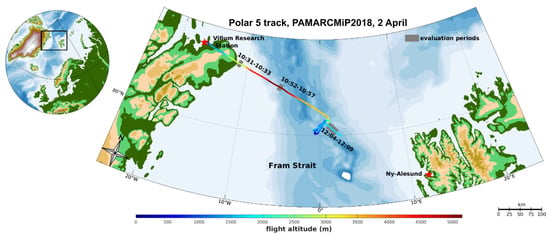Does the Intra-Arctic Modification of Long-Range Transported Aerosol Affect the Local Radiative Budget? (A Case Study)
Abstract
1. Introduction
2. Methods: Instrumentation and Modeling Tools
2.1. Lidar Systems
2.2. Sun-Photometers and Extinction Estimation at Fram Strait
2.3. Aerosol Microphysical Properties Inversion Schemes
2.4. Trajectory Calculations for Air-Mass History
2.5. Radiation and Meteorological Observations
2.6. Radiative Transfer Simulations
3. Aerosol Observations over the European Arctic and Meteorological Conditions
4. Results
4.1. Episode Evolution over Ny-Ålesund and Connection to Air Masses
4.2. Origin of Observed Aerosol Over Fram Strait and Ny-Ålesund
4.3. Modification of Aerosol Optical Properties
4.4. Modification of Aerosol Microphysical Properties
4.5. Aerosol Radiative Effect (ARE)
4.6. ARE Uncertainties and Comparison to WV-Related Radiative Effect
5. Discussion
6. Summary and Conclusions
- This transport episode stood out due to its considerable altitude, with such elevated aerosol layers predicted by aerosol climate models but rarely observed [14,60,61]. Generalizing the findings from our radiative transfer simulations, geometrically higher aerosol layers will produce a warming effect at higher tropospheric levels. Since these aerosol mixtures cool the surface, and hence near-surface air, but warm the surrounding air, the tropospheric stratification will be stabilized. Hence, the vertical propagation of heat and radiation fluxes will be suppressed. The latter applies for similar aerosol mixtures aloft bright surfaces during early spring.
- The aerosol size distribution was clearly modified between the two Arctic locations. The effective radius of the accumulation mode decreased, while the coarse mode was depleted (Figure 9). Industrial pollution and biomass-burning aerosol were funneled to Fram Strait and Ny-Ålesund, Svalbard. In the beginning, aged air masses originating from Asia dominated, while in the course of the episode they mixed with less mature air from northern Europe (Figure 6). Solely, the modified aerosol sources and dry deposition could not account for the elimination of the coarse mode. However, high-level clouds in the interim of the two observations indicate the presence of nucleation scavenging (Figure S1).
- Along the intra-Arctic transport, particles presented a significantly higher Lidar ratio at visible wavelengths (LR532 increased from 15 sr to 64–82 sr). A possible increased absorption can be attributed to black carbon, which could be transported at longer distances as interstitial aerosol since it has low deposition ability [82] and, thus, a longer lifetime. Moreover, black carbon could have been advected through neighboring north European intrusions.
- Despite the coarse mode depletion and increased Lidar ratio, the microphysical similarities of the accumulation mode led to an indistinguishable short-wave radiative footprint in the two episode stages. The accumulation mode drives visible solar irradiance and, thus, dominates the short-wave radiative budget. Thus, the atmospheric column aerosol radiative effect bore similarities over the two locations, amounting to +4.4–4.9 W m−2 over the ice-covered Fram Strait and +4.5 W m−2 over the snow-covered Ny-Ålesund. This episode caused top-of-atmosphere warming accompanied by surface cooling, with implications for atmospheric stratification.
- The aerosol radiative effect was more significant compared to the ambient humidity effect on a weekly basis (30% WV mixing ratio perturbation).
- Our study suggests that within this Arctic haze episode, which was dominated by accumulation mode particles, the intra-Arctic aerosol modification (and hence, the precise aerosol microphysics) had little effect on the local radiative budget. However, in the context of retreating Arctic sea ice and declining surface albedo [86], the local aerosol radiative effect may change along individual transport episodes.
Supplementary Materials
Author Contributions
Funding
Acknowledgments
Conflicts of Interest
References
- Breider, T.J.; Mickley, L.J.; Jacob, D.J.; Ge, C.; Wang, J.; Payer Sulprizio, M.; Croft, B.; Ridley, D.A.; McConnell, J.R.; Sharma, S. Multidecadal trends in aerosol radiative forcing over the Arctic: Contribution of changes in anthropogenic aerosol to Arctic warming since 1980. J. Geophys. Res. Atmos. 2017, 122, 3573–3594. [Google Scholar] [CrossRef]
- Bellouin, N.; Quaas, J.; Gryspeerdt, E.; Kinne, S.; Stier, P.; Watson-Parris, D.; Boucher, O.; Carslaw, K.S.; Christensen, M.; Daniau, A.-L. Bounding global aerosol radiative forcing of climate change. Rev. Geophys. 2019, 58, e2019RG000660. [Google Scholar] [CrossRef]
- Sand, M.; Samset, B.H.; Balkanski, Y.; Bauer, S.; Bellouin, N.; Berntsen, T.K.; Bian, H.; Chin, M.; Diehl, T.; Easter, R. Aerosols at the poles: An AeroCom Phase II multi-model evaluation. Atmos. Chem. Phys. 2017, 17, 12197–12218. [Google Scholar] [CrossRef]
- Najafi, M.R.; Zwiers, F.W.; Gillett, N.P. Attribution of Arctic temperature change to greenhouse-gas and aerosol influences. Nat. Clim. Chang. 2015, 5, 246–249. [Google Scholar] [CrossRef]
- Serreze, M.C.; Barry, R.G. Processes and impacts of Arctic amplification: A research synthesis. Glob. Planet. Chang. 2011, 77, 85–96. [Google Scholar] [CrossRef]
- Wendisch, M.; Brückner, M.; Burrows, J.P.; Crewell, S.; Dethloff, K.; Ebell, K.; Lüpkes, C.; Macke, A.; Notholt, J.; Quaas, J. Understanding causes and effects of rapid warming in the Arctic. Eos 2017, 98. [Google Scholar] [CrossRef]
- Korhonen, H.; Carslaw, K.S.; Spracklen, D.V.; Ridley, D.A.; Ström, J. A global model study of processes controlling aerosol size distributions in the Arctic spring and summer. J. Geophys. Res. Atmos. 2008, 113. [Google Scholar] [CrossRef]
- Croft, B.; Martin, R.V.; Leaitch, W.R.; Tunved, P.; Breider, T.J.; D’Andrea, S.D.; Pierce, J.R. Processes controlling the annual cycle of Arctic aerosol number and size distributions. Atmos. Chem. Phys. 2016, 16, 3665–3682. [Google Scholar] [CrossRef]
- Freud, E.; Krejci, R.; Tunved, P.; Leaitch, R.; Nguyen, Q.T.; Massling, A.; Skov, H.; Barrie, L. Pan-Arctic aerosol number size distributions: Seasonality and transport patterns. Atmos. Chem. Phys. 2017, 17, 8101–8128. [Google Scholar] [CrossRef]
- Schmeisser, L.; Backman, J.; Ogren, J.A.; Andrews, E.; Asmi, E.; Starkweather, S.; Uttal, T.; Fiebig, M.; Sharma, S.; Eleftheriadis, K. Seasonality of aerosol optical properties in the Arctic. Atmos. Chem. Phys. 2018, 18, 11599–11622. [Google Scholar] [CrossRef]
- Quinn, P.K.; Shaw, G.; Andrews, E.; Dutton, E.G.; Ruoho-Airola, T.; Gong, S.L. Arctic haze: Current trends and knowledge gaps. Tellus B Chem. Phys. Meteorol. 2007, 59, 99–114. [Google Scholar] [CrossRef]
- Warneke, C.; Bahreini, R.; Brioude, J.; Brock, C.A.; De Gouw, J.A.; Fahey, D.W.; Froyd, K.D.; Holloway, J.S.; Middlebrook, A.; Miller, L. Biomass burning in Siberia and Kazakhstan as an important source for haze over the Alaskan Arctic in April 2008. Geophys. Res. Lett. 2009, 36. [Google Scholar] [CrossRef]
- Di Pierro, M.; Jaeglé, L.; Eloranta, E.W.; Sharma, S. Spatial and seasonal distribution of Arctic aerosols observed by CALIOP (2006–2012). Atmos. Chem. Phys. Discuss. 2013, 13, 7075–7095. [Google Scholar] [CrossRef]
- Ritter, C.; Neuber, R.; Schulz, A.; Markowicz, K.M.; Stachlewska, I.S.; Lisok, J.; Makuch, P.; Pakszys, P.; Markuszewski, P.; Rozwadowska, A. 2014 iAREA campaign on aerosol in Spitsbergen–Part 2: Optical properties from Raman-lidar and in-situ observations at Ny-\AAlesund. Atmos. Environ. 2016, 141, 1–19. [Google Scholar] [CrossRef][Green Version]
- Shibata, T.; Shiraishi, K.; Shiobara, M.; Iwasaki, S.; Takano, T. Seasonal Variations in High Arctic Free Tropospheric Aerosols Over Ny-\AAlesund, Svalbard, Observed by Ground-Based Lidar. J. Geophys. Res. Atmos. 2018, 123, 12–353. [Google Scholar] [CrossRef]
- Klonecki, A.; Hess, P.; Emmons, L.; Smith, L.; Orlando, J. Seasonal changes in the transport of pollutants into the Arctic troposphere-model study: Tropospheric Ozone Production about the Spring Equinox (TOPSE). J. Geophys. Res. 2003, 108, TOP15-1. [Google Scholar] [CrossRef]
- Stohl, A. Characteristics of atmospheric transport into the Arctic troposphere. J. Geophys. Res. Atmos. 2006, 111, 0148–0227. [Google Scholar] [CrossRef]
- Di Pierro, M.; Jaeglé, L. Satellite observations of aerosol transport from East Asia to the Arctic: Three case studies. Atmos. Chem. Phys. 2011, 11, 2225. [Google Scholar] [CrossRef]
- Eleftheriadis, K.; Vratolis, S.; Nyeki, S. Aerosol black carbon in the European Arctic: Measurements at Zeppelin station, Ny-\AAlesund, Svalbard from 1998–2007. Geophys. Res. Lett. 2009, 36. [Google Scholar] [CrossRef]
- Lisok, J.; Markowicz, K.M.; Ritter, C.; Makuch, P.; Petelski, T.; Chilinski, M.; Kaminski, J.W.; Becagli, S.; Traversi, R.; Udisti, R. 2014 iAREA campaign on aerosol in Spitsbergen–Part 1: Study of physical and chemical properties. Atmos. Environ. 2016, 140, 150–166. [Google Scholar] [CrossRef]
- Moroni, B.; Arnalds, O.; Dagsson-Waldhauserová, P.; Crocchianti, S.; Vivani, R.; Cappelletti, D. Mineralogical and chemical records of Icelandic dust sources upon Ny-\AAlesund (Svalbard Islands). Front. Earth Sci. 2018, 6, 187. [Google Scholar] [CrossRef]
- Ferrero, L.; Ritter, C.; Cappelletti, D.; Moroni, B.; Močnik, G.; Mazzola, M.; Lupi, A.; Becagli, S.; Traversi, R.; Cataldi, M. Aerosol optical properties in the Arctic: The role of aerosol chemistry and dust composition in a closure experiment between Lidar and tethered balloon vertical profiles. Sci. Total Environ. 2019, 686, 452–467. [Google Scholar] [CrossRef] [PubMed]
- Law, K.S.; Stohl, A. Arctic air pollution: Origins and impacts. Science 2007, 315, 1537–1540. [Google Scholar] [CrossRef] [PubMed]
- Stock, M.; Ritter, C.; Herber, A.; von Hoyningen-Huene, W.; Baibakov, K.; Graeser, J.; Orgis, T.; Treffeisen, R.; Zinoviev, N.; Makshtas, A. Springtime Arctic aerosol: Smoke versus haze, a case study for March 2008. Atmos. Environ. 2012, 52, 48–55. [Google Scholar] [CrossRef][Green Version]
- Quennehen, B.; Schwarzenboeck, A.; Matsuki, A.; Burkhart, J.F.; Stohl, A.; Ancellet, G.; Law, K.S. Anthropogenic and forest fire pollution aerosol transported to the Arctic: Observations from the POLARCAT-France spring campaign. Atmos. Chem. Phys. 2012. [Google Scholar] [CrossRef]
- Monks, S.A.; Arnold, S.R.; Emmons, L.K.; Law, K.S.; Turquety, S.; Duncan, B.N.; Flemming, J.; Huijnen, V.; Tilmes, S.; Langner, J. Multi-model study of chemical and physical controls on transport of anthropogenic and biomass burning pollution to the Arctic. Atmos. Chem. Phys. 2015, 15, 3575–3603. [Google Scholar] [CrossRef]
- Evangeliou, N.; Balkanski, Y.; Hao, W.; Petkov, A.; Silverstein, R.P.; Corley, R.; Nordgren, B.L.; Urbanski, S.; Eckhardt, S.; Stohl, A. Wildfires in northern Eurasia affect the budget of black carbon in the Arctic-a 12-year retrospective synopsis (2002–2013). Atmos. Chem. Phys. 2016, 16, 7587–7604. [Google Scholar] [CrossRef]
- Gjelten, H.M.; Nordli, Ø.; Isaksen, K.; Førland, E.J.; Sviashchennikov, P.N.; Wyszynski, P.; Prokhorova, U.V.; Przybylak, R.; Ivanov, B.V.; Urazgildeeva, A.V. Air temperature variations and gradients along the coast and fjords of western Spitsbergen. Polar Res. 2016, 35, 29878. [Google Scholar] [CrossRef]
- Dahlke, S.; Hughes, N.E.; Wagner, P.M.; Gerland, S.; Wawrzyniak, T.; Ivanov, B.; Maturilli, M. The observed recent surface air temperature development across Svalbard and concurring footprints in local sea ice cover. Int. J. Climatol. 2020. [Google Scholar] [CrossRef]
- Dahlke, S.; Maturilli, M. Contribution of atmospheric advection to the amplified winter warming in the Arctic North Atlantic region. Adv. Meteorol. 2017, 1687–9309. [Google Scholar] [CrossRef]
- Woods, C.; Caballero, R.; Svensson, G. Large-scale circulation associated with moisture intrusions into the Arctic during winter. Geophys. Res. Lett. 2013, 40, 4717–4721. [Google Scholar] [CrossRef]
- Graßl, S.; Ritter, C. Properties of Arctic Aerosol Based on Sun Photometer Long-Term Measurements in Ny-\AAlesund, Svalbard. Remote Sens. 2019, 11, 1362. [Google Scholar] [CrossRef]
- Binietoglou, I.; D’Amico, G.; Baars, H.; Belegante, L.; Marinou, E. A methodology for cloud masking uncalibrated lidar signals. In Proceedings of the EPJ Web of Conferences; EDP Sciences: Les Ulis, France, 2018; Volume 176, p. 05048. [Google Scholar]
- Böckmann, C. Hybrid regularization method for the ill-posed inversion of multiwavelength lidar data in the retrieval of aerosol size distributions. Appl. Opt. 2001, 40, 1329–1342. [Google Scholar] [CrossRef] [PubMed]
- Böckmann, C.; Kirsche, A. Iterative regularization method for lidar remote sensing. Comput. Phys. Commun. 2006, 174, 607–615. [Google Scholar] [CrossRef]
- Osterloh, L.; Böckmann, C.; Mamouri, R.-E.; Papayannis, A. An adaptive base point algorithm for the retrieval of aerosol microphysical properties. Open Atmos. Sci. J. 2011, 5, 61–73. [Google Scholar] [CrossRef]
- Samaras, S.; Nicolae, D.; Böckmann, C.; Vasilescu, J.; Binietoglou, I.; Labzovskii, L.; Toanca, F.; Papayannis, A. Using Raman-lidar-based regularized microphysical retrievals and Aerosol Mass Spectrometer measurements for the characterization of biomass burning aerosols. J. Comput. Phys. 2015, 299, 156–174. [Google Scholar] [CrossRef]
- Stachlewska, I.S.; Neuber, R.; Lampert, A.; Ritter, C.; Wehrle, G. AMALi the Airborne Mobile Aerosol Lidar for Arctic research. Atmos. Chem. Phys. 2010, 10, 2947–2963. [Google Scholar] [CrossRef]
- Hoffmann, A. Comparative Aerosol Studies Based on Multi-Wavelength Raman LIDAR at Ny-\AAlesund, Spitsbergen. Ph.D. Thesis, University Potsdam, Potsdam, Germany, 2011. [Google Scholar]
- Iarlori, M.; Madonna, F.; Rizi, V.; Trickl, T.; Amodeo, A. Effective resolution concepts for lidar observations. Atmos. Meas. Tech. Discuss. 2015, 8, 5157–5176. [Google Scholar] [CrossRef]
- Fernald, F.G. Analysis of atmospheric lidar observations: Some comments. Appl. Opt. 1984, 23, 652–653. [Google Scholar] [CrossRef] [PubMed]
- Klett, J.D. Stable analytical inversion solution for processing lidar returns. Appl. Opt. 1981, 20, 211–220. [Google Scholar] [CrossRef]
- Ansmann, A.; Riebesell, M.; Weitkamp, C. Measurement of atmospheric aerosol extinction profiles with a Raman lidar. Opt. Lett. 1990, 15, 746–748. [Google Scholar] [CrossRef] [PubMed]
- Mei, L.; Vandenbussche, S.; Rozanov, V.; Proestakis, E.; Amiridis, V.; Callewaert, S.; Vountas, M.; Burrows, J.P. On the retrieval of aerosol optical depth over cryosphere using passive remote sensing. Remote Sens. Environ. 2020, 241, 111731. [Google Scholar] [CrossRef]
- Alexandrov, M.D.; Marshak, A.; Cairns, B.; Lacis, A.A.; Carlson, B.E. Automated cloud screening algorithm for MFRSR data. Geophys. Res. Lett. 2004, 31. [Google Scholar] [CrossRef]
- Müller, D.; Böckmann, C.; Kolgotin, A.; Schneidenbach, L.; Chemyakin, E.; Rosemann, J.; Znak, P.; Romanov, A. Microphysical particle properties derived from inversion algorithms developed in the framework of EARLINET. Atmos. Meas. Tech. 2016, 9, 5007–5035. [Google Scholar] [CrossRef]
- Sprenger, M.; Wernli, H. The LAGRANTO Lagrangian analysis tool—Version 2.0. Geosci. Model Dev. 2015, 8, 2569–2586. [Google Scholar] [CrossRef]
- Wernli, B.H.; Davies, H.C. A Lagrangian-based analysis of extratropical cyclones. I: The method and some applications. Q. J. R. Meteorol. Soc. 1997, 123, 467–489. [Google Scholar] [CrossRef]
- Ehrlich, A.; Wendisch, M. Reconstruction of high-resolution time series from slow-response broadband terrestrial irradiance measurements by deconvolution. Atmos. Meas. Tech. 2015, 8, 3671–3684. [Google Scholar] [CrossRef]
- Herber, A. Meteorological Observations during POLAR 5 Campaign PAMARCMIP 2018; Alfred Wegener Institute, Helmholtz Centre for Polar and Marine Research: Bremerhaven, Germany, 2019. [Google Scholar]
- Burba, G.G.; McDermitt, D.K.; Anderson, D.J.; Furtaw, M.D.; Eckles, R.D. Novel design of an enclosed CO2/H2O gas analyser for eddy covariance flux measurements. Tellus B: Chem. Phys. Meteorol. 2010, 62, 743–748. [Google Scholar] [CrossRef]
- Maturilli, M.; Herber, A.; König-Langlo, G. Surface radiation climatology for Ny-\AAlesund, Svalbard (78.9 N), basic observations for trend detection. Theor. Appl. Climatol. 2015, 120, 331–339. [Google Scholar] [CrossRef]
- Maturilli, M. Basic and Other Measurements of Radiation at Station Ny-Ålesund (2018-04); Alfred Wegener Institute—Research Unit Potsdam: Potsdam, Germany, 2018. [Google Scholar]
- Maturilli, M. High Resolution Radiosonde Measurements from Station Ny-Ålesund (2018-04); Alfred Wegener Institute—Research Unit Potsdam: Potsdam, Germany, 2018. [Google Scholar]
- Rozanov, V.V.; Rozanov, A.V.; Kokhanovsky, A.A.; Burrows, J.P. Radiative transfer through terrestrial atmosphere and ocean: Software package SCIATRAN. J. Quant. Spectrosc. Radiat. Transf. 2014, 133, 13–71. [Google Scholar] [CrossRef]
- Rothman, L.S.; Barbe, A.; Benner, D.C.; Brown, L.R.; Camy-Peyret, C.; Carleer, M.R.; Chance, K.; Clerbaux, C.; Dana, V.; Devi, V.M. The HITRAN molecular spectroscopic database: Edition of 2000 including updates through 2001. J. Quant. Spectrosc. Radiat. Transf. 2003, 82, 5–44. [Google Scholar] [CrossRef]
- Sinnhuber, B.-M.; Sheode, N.; Sinnhuber, M.; Chipperfield, M.P.; Feng, W. The contribution of anthropogenic bromine emissions to past stratospheric ozone trends: A modelling study. Atmos. Chem. Phys. 2009, 9, 2863–2871. [Google Scholar] [CrossRef]
- Yamanouchi, T.; Treffeisen, R.; Herber, A.; Shiobara, M.; Yamagata, S.; Hara, K.; Sato, K.; Yabuki, M.; Tomikawa, Y.; Rinke, A. Arctic study of tropospheric aerosol and radiation (ASTAR) 2000: Arctic haze case study. Tellus B: Chem. Phys. Meteorol. 2005, 57, 141–152. [Google Scholar] [CrossRef]
- Lazaridis, M.; Hov, Ø.; Eleftheriadis, K. Heterogeneous nucleation on rough surfaces: Implications to atmospheric aerosols. Atmos. Res. 2000, 55, 103–113. [Google Scholar] [CrossRef]
- Hoffmann, A.; Osterloh, L.; Stone, R.; Lampert, A.; Ritter, C.; Stock, M.; Tunved, P.; Hennig, T.; Böckmann, C.; Li, S.-M. Remote sensing and in-situ measurements of tropospheric aerosol, a PAMARCMiP case study. Atmos. Environ. 2012, 52, 56–66. [Google Scholar] [CrossRef]
- Ritter, C.; Angeles Burgos, M.; Böckmann, C.; Mateos, D.; Lisok, J.; Markowicz, K.M.; Moroni, B.; Cappelletti, D.; Udisti, R.; Maturilli, M. Microphysical properties and radiative impact of an intense biomass burning aerosol event measured over Ny-\AAlesund, Spitsbergen in July 2015. Tellus B Chem. Phys. Meteorol. 2018, 70, 1–23. [Google Scholar] [CrossRef]
- Schacht, J.; Heinold, B.; Quaas, J.; Backman, J.; Cherian, R.; Ehrlich, A.; Herber, A.; Huang, W.T.; Kondo, Y.; Massling, A. The importance of the representation of air pollution emissions for the modeled distribution and radiative effects of black carbon in the Arctic. Atmos. Chem. Phys. 2019, 19, 11159–11183. [Google Scholar] [CrossRef]
- Schwarz, J.P.; Weinzierl, B.; Samset, B.H.; Dollner, M.; Heimerl, K.; Markovic, M.Z.; Perring, A.E.; Ziemba, L. Aircraft measurements of black carbon vertical profiles show upper tropospheric variability and stability. Geophys. Res. Lett. 2017, 44, 1132–1140. [Google Scholar] [CrossRef]
- Schwarz, J.P.; Samset, B.H.; Perring, A.E.; Spackman, J.R.; Gao, R.S.; Stier, P.; Schulz, M.; Moore, F.L.; Ray, E.A.; Fahey, D.W. Global-scale seasonally resolved black carbon vertical profiles over the Pacific. Geophys. Res. Lett. 2013, 40, 5542–5547. [Google Scholar] [CrossRef]
- Mizuta, R. Intensification of extratropical cyclones associated with the polar jet change in the CMIP5 global warming projections. Geophys. Res. Lett. 2012, 39. [Google Scholar] [CrossRef]
- Lambert, S.J.; Fyfe, J.C. Changes in winter cyclone frequencies and strengths simulated in enhanced greenhouse warming experiments: Results from the models participating in the IPCC diagnostic exercise. Clim. Dyn. 2006, 26, 713–728. [Google Scholar] [CrossRef]
- Barriopedro, D.; García-Herrera, R.; Lupo, A.R.; Hernández, E. A Climatology of Northern Hemisphere Blocking. J. Clim. 2006, 19, 1042–1063. [Google Scholar] [CrossRef]
- Garrett, T.; Zhao, C.; Novelli, P. Assessing the relative contributions of transport efficiency and scavenging to seasonal variability in Arctic aerosol. Tellus B Chem. Phys. Meteorol. 2010, 62, 190–196. [Google Scholar] [CrossRef]
- Seinfeld, J.H.; Pandis, S.N. Atmospheric Chemistry and Physics: From Air Pollution to Climate Change; John Wiley & Sons: Hoboken, NJ, USA, 2016. [Google Scholar]
- Fletcher, N.H.J. Size effect in heterogeneous nucleation. J. Chem. Phys. 1958, 29, 572–576. [Google Scholar] [CrossRef]
- Nicolae, D.; Nemuc, A.; Müller, D.; Talianu, C.; Vasilescu, J.; Belegante, L.; Kolgotin, A. Characterization of fresh and aged biomass burning events using multiwavelength Raman lidar and mass spectrometry. J. Geophys. Res. Atmos. 2013, 118, 2956–2965. [Google Scholar] [CrossRef]
- Hoffmann, A.; Ritter, C.; Stock, M.; Shiobara, M.; Lampert, A.; Maturilli, M.; Orgis, T.; Neuber, R.; Herber, A. Ground-based lidar measurements from Ny-\AAlesund during ASTAR 2007: A statistical overview. Atmos. Chem. Phys. Discuss 2009, 9, 15453–15510. [Google Scholar] [CrossRef]
- Tunved, P.; Ström, J.; Krejci, R. Arctic aerosol life cycle: Linking aerosol size distributions observed between 2000 and 2010 with air mass transport and precipitation at Zeppelin station, Ny-\AA lesund, Svalbard. Atmos. Chem. Phys. 2013, 13, 3643–3660. [Google Scholar] [CrossRef]
- Mei, L.; Rozanov, V.; Ritter, C.; Heinold, B.; Jiao, Z.; Vountas, M.; Burrows, J.P. Retrieval of aerosol optical thickness in the Arctic snow-covered regions using passive remote sensing: Impact of aerosol typing and surface reflection model. IEEE Trans. Geosci. Remote Sens. 2020, 58, 5117–5131. [Google Scholar] [CrossRef]
- Janicka, L.; Stachlewska, I.S.; Veselovskii, I.; Baars, H. Temporal variations in optical and microphysical properties of mineral dust and biomass burning aerosol derived from daytime Raman lidar observations over Warsaw, Poland. Atmos. Environ. 2017, 169, 162–174. [Google Scholar] [CrossRef]
- Ortiz-Amezcua, P.; Guerrero-Rascado, J.L.; Granados-Muñoz, M.J.; Benavent-Oltra, J.A.; Böckmann, C.; Samaras, S.; Stachlewska, I.S.; Janicka, L.; Baars, H.; Bohlmann, S. Microphysical characterization of long-range transported biomass burning particles from North America at three EARLINET stations. Atmos. Chem. Phys. 2019, 17, 5931–5946. [Google Scholar] [CrossRef]
- Giannakaki, E.; Van Zyl, P.G.; Müller, D.; Balis, D.; Komppula, M. Optical and microphysical characterization of aerosol layers over South Africa by means of multi-wavelength depolarization and Raman lidar measurements. Atmos. Chem. Phys. 2016, 16, 8109–8123. [Google Scholar] [CrossRef]
- Haarig, M.; Ansmann, A.; Baars, H.; Jimenez, C.; Veselovskii, I.; Engelmann, R.; Althausen, D. Depolarization and lidar ratios at 355, 532, and 1064 nm and microphysical properties of aged tropospheric and stratospheric Canadian wildfire smoke. Atmos. Chem. Phys. 2018, 18, 11847–11861. [Google Scholar] [CrossRef]
- Janicka, L.; Stachlewska, I.S. Properties of biomass burning aerosol mixtures derived at fine temporal and spatial scales from Raman lidar measurements: Part I optical properties. Atmos. Chem. Phys. Discuss 2019, 1–46. [Google Scholar] [CrossRef]
- Groß, S.; Esselborn, M.; Weinzierl, B.; Wirth, M.; Fix, A.; Petzold, A. Aerosol classification by airborne high spectral resolution lidar observations. Atmos. Chem. Phys. 2013, 13, 2487. [Google Scholar] [CrossRef]
- Donth, T.; Jäkel, E.; Ehrlich, A.; Heinold, B.; Schacht, J.; Herber, A.; Zanatta, M.; Wendisch, M. Combining atmospheric and snow layer radiative transfer models to assess the solar radiative effects of black carbon in the Arctic. Atmos. Chem. Phys. Discuss. 2020, 1–26. [Google Scholar] [CrossRef]
- Macdonald, K.M.; Sharma, S.; Toom, D.; Chivulescu, A.; Hanna, S.; Bertram, A.K.; Platt, A.; Elsasser, M.; Huang, L.; Tarasick, D. Observations of atmospheric chemical deposition to high Arctic snow. Atmos. Chem. Phys. 2017, 17, 5775–5788. [Google Scholar] [CrossRef]
- Papagiannopoulos, N.; Alados Arboledas, L.; Guerrero-Rascado, J.L. An automatic observation-based aerosol typing method for EARLINET. Atmos. Chem. Phys. 2018, 18, 15879–15901. [Google Scholar] [CrossRef]
- Giannakaki, E.; Kokkalis, P.; Marinou, E.; Bartsotas, N.S.; Amiridis, V.; Ansmann, A.; Komppula, M. The potential of elastic and polarization lidars to retrieve extinction profiles. Atmos. Meas. Tech. 2020, 13, 893–905. [Google Scholar] [CrossRef]
- Zielinski, T.; Bolzacchini, E.; Cataldi, M.; Ferrero, L.; Graßl, S.; Hansen, G.; Mateos, D.; Mazzola, M.; Neuber, R.; Pakszys, P.; et al. Study of Chemical and Optical Properties of Biomass Burning Aerosols during Long-Range Transport Events toward the Arctic in Summer 2017. Atmosphere 2020, 11, 84. [Google Scholar] [CrossRef]
- Döscher, R.; Vihma, T.; Maksimovich, E. Recent advances in understanding the Arctic climate system state and change from a sea ice perspective: A review. Atmos. Chem. Phys. 2014, 14, 13571–13600. [Google Scholar] [CrossRef]
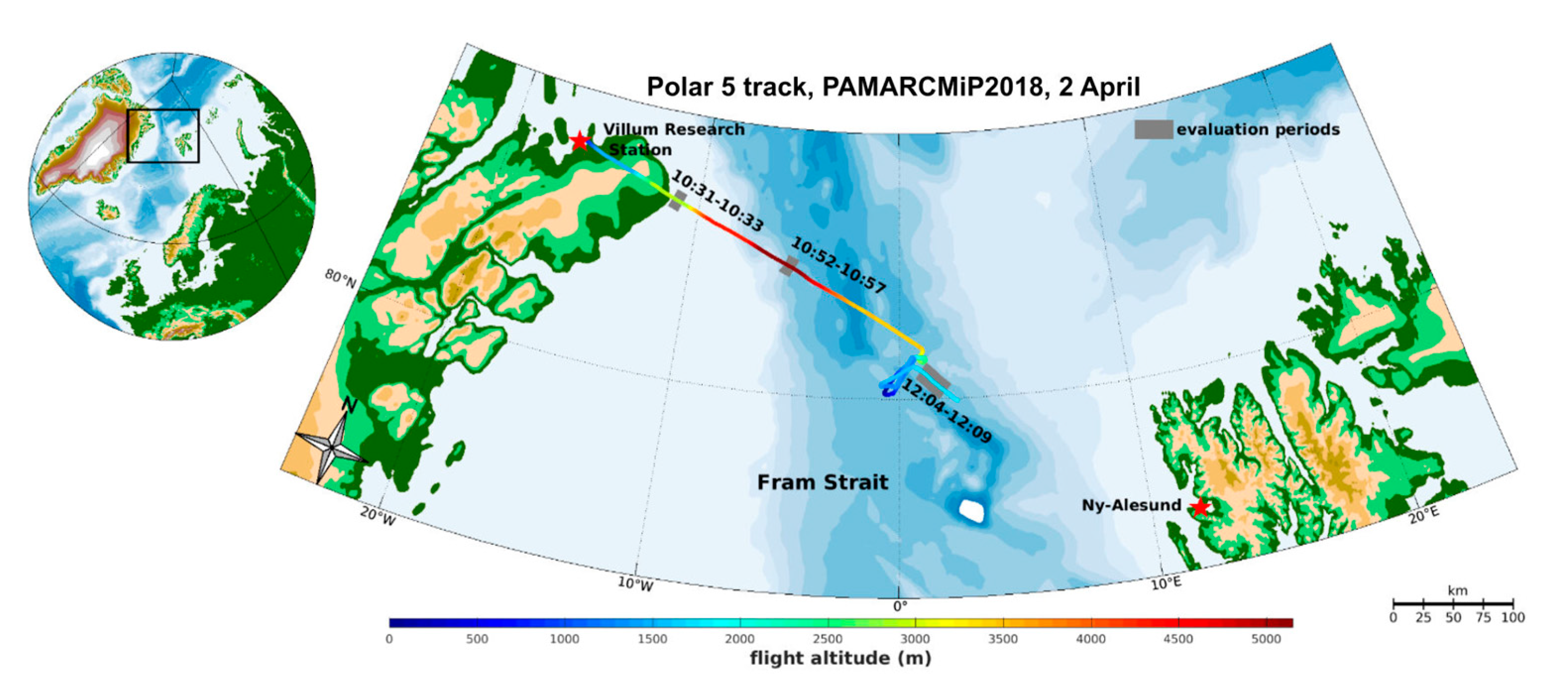
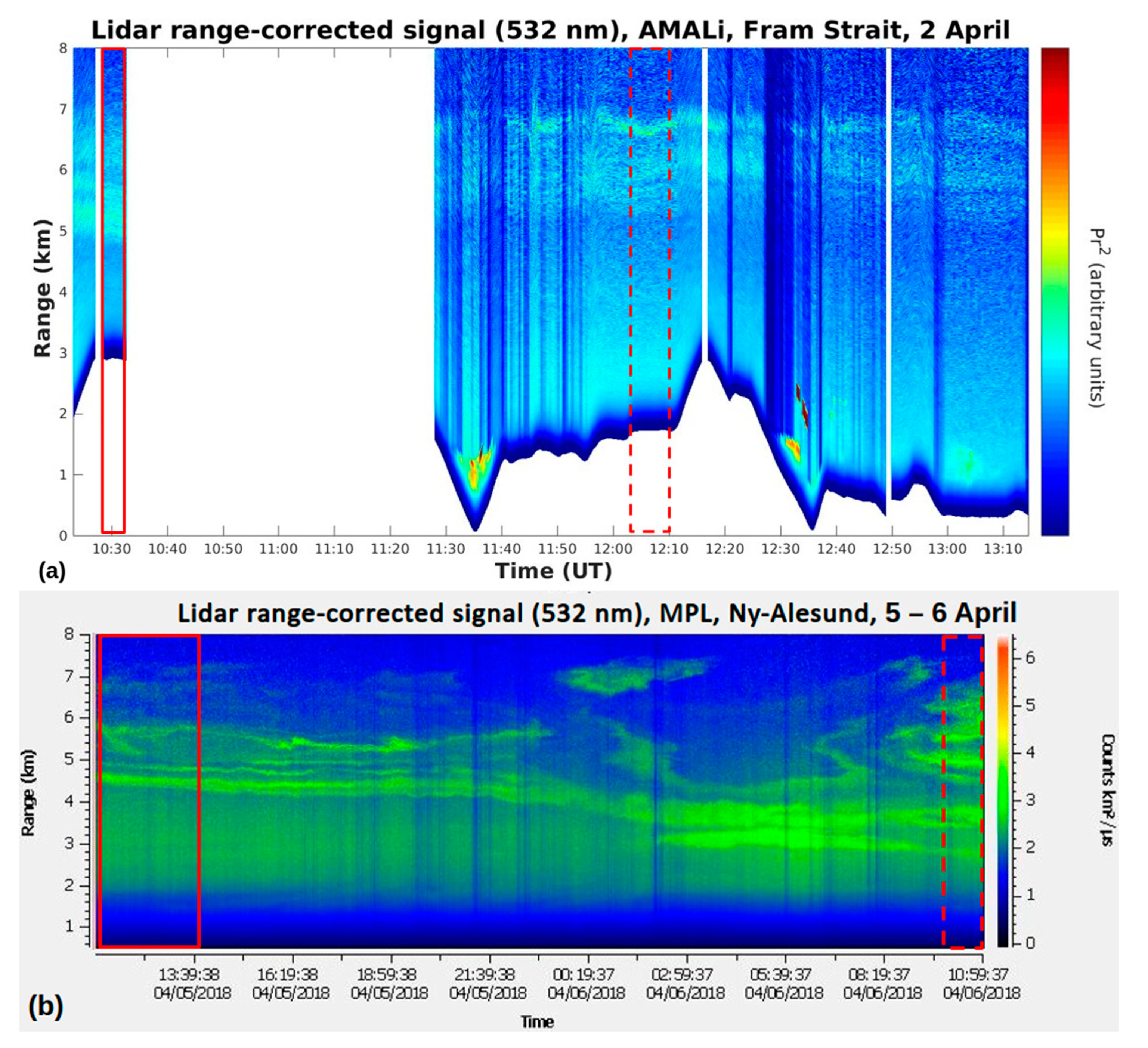
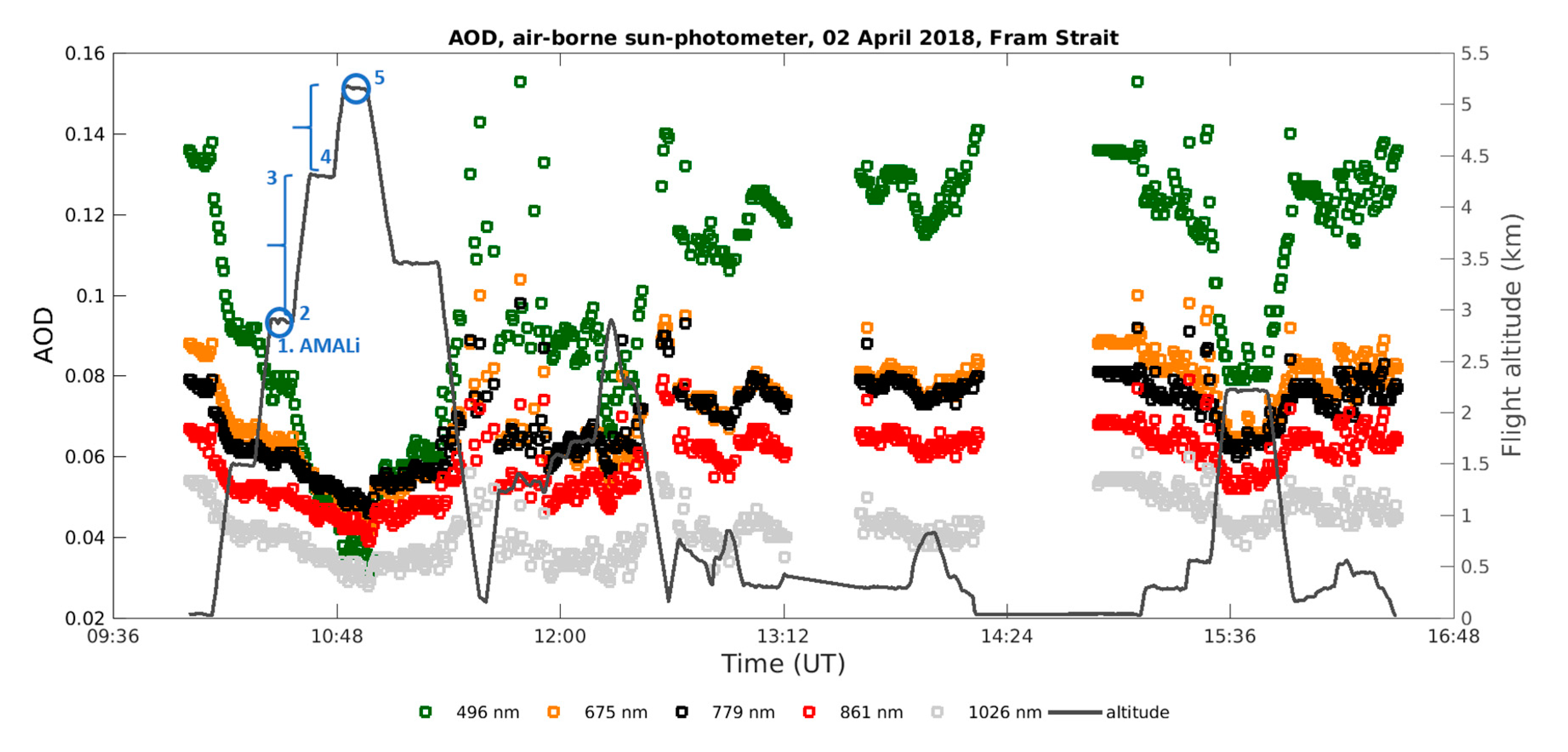
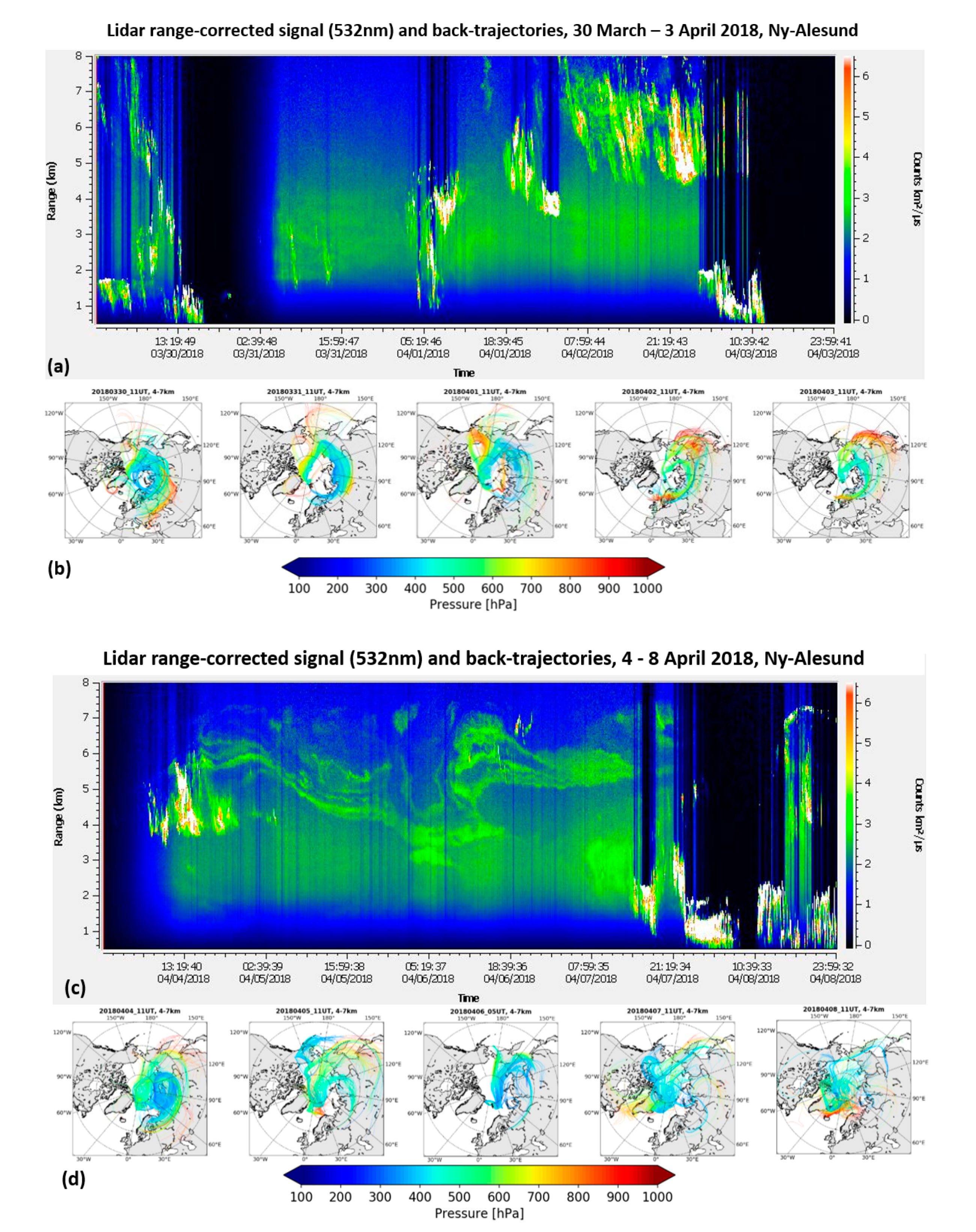

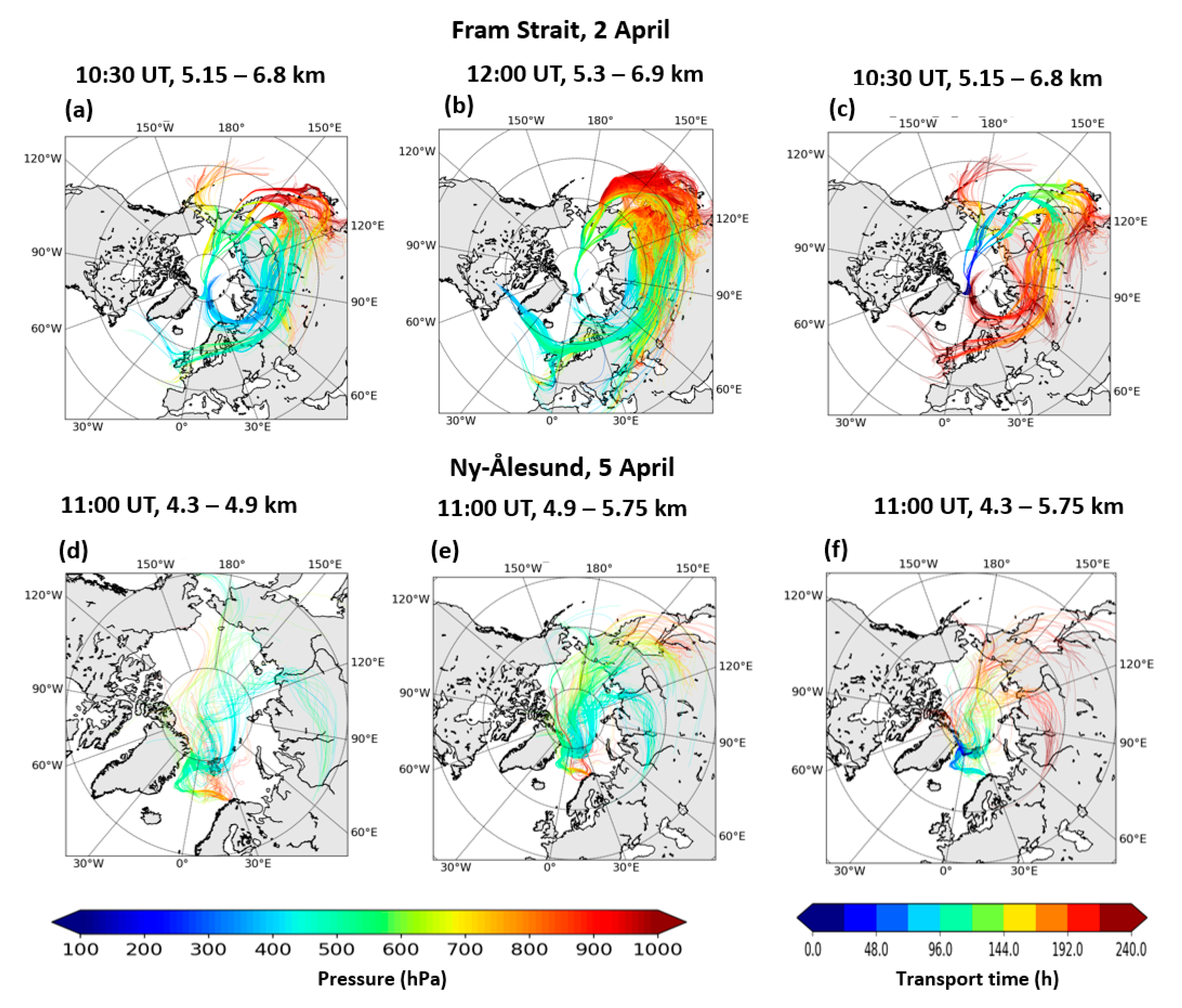
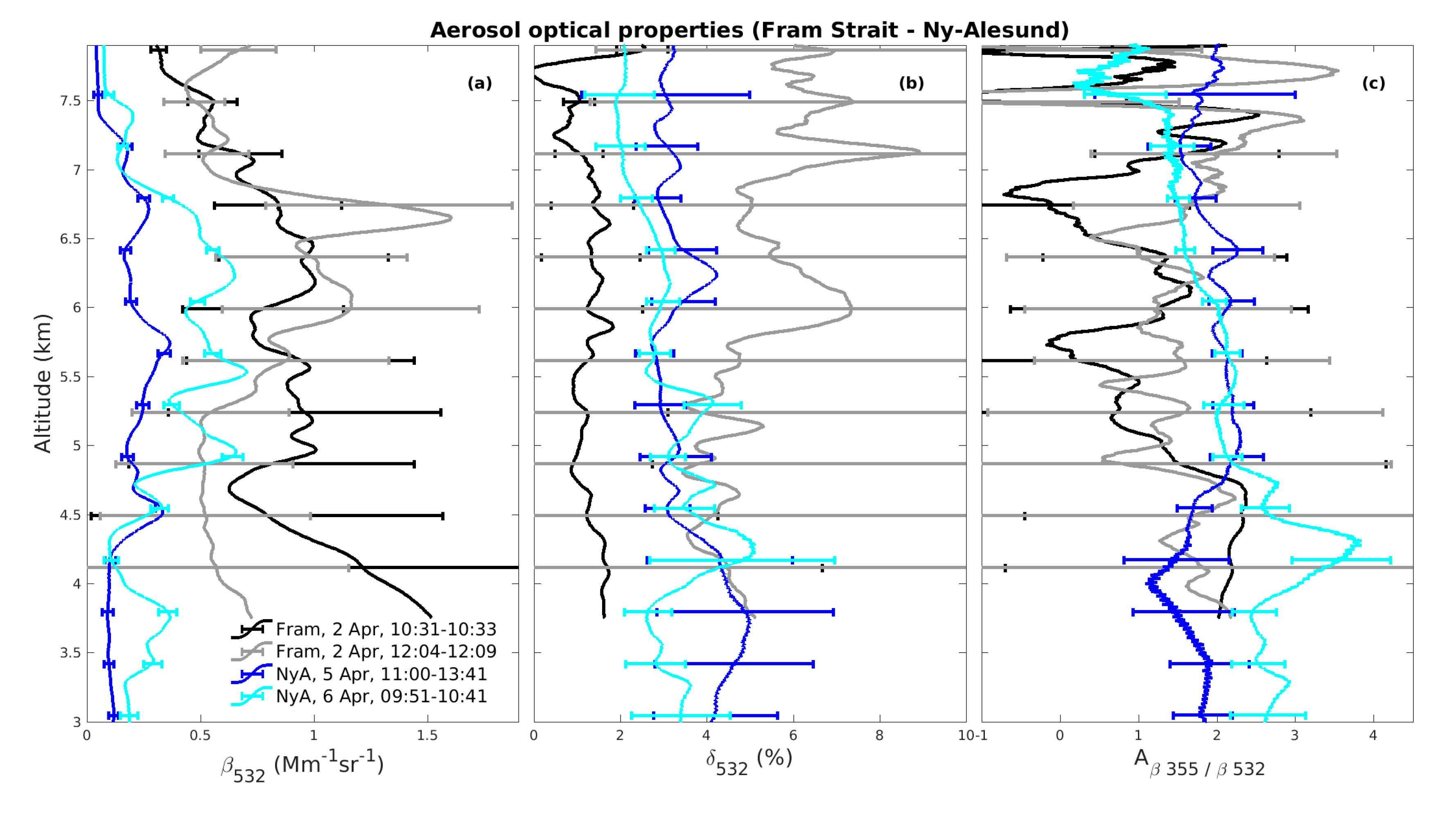
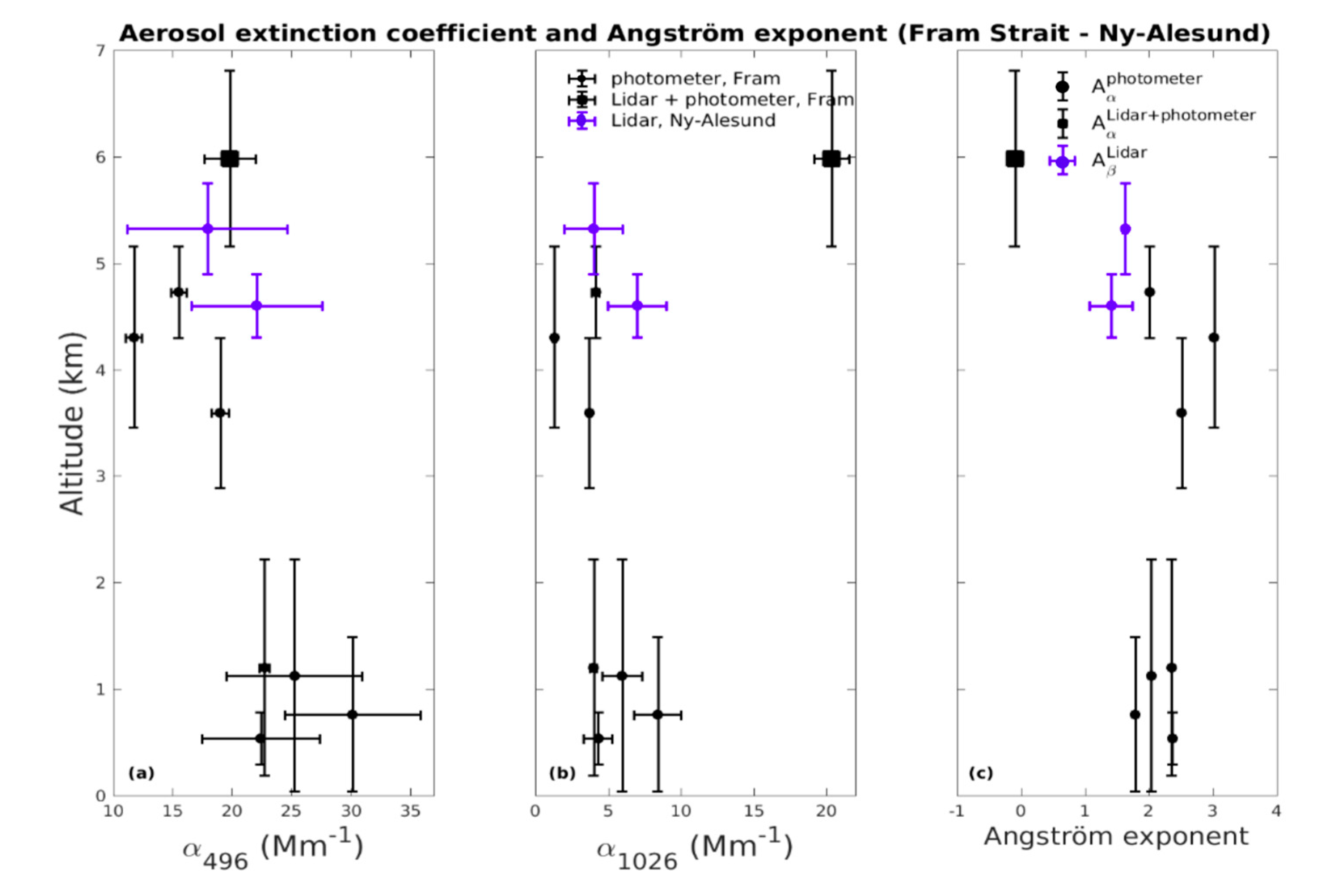
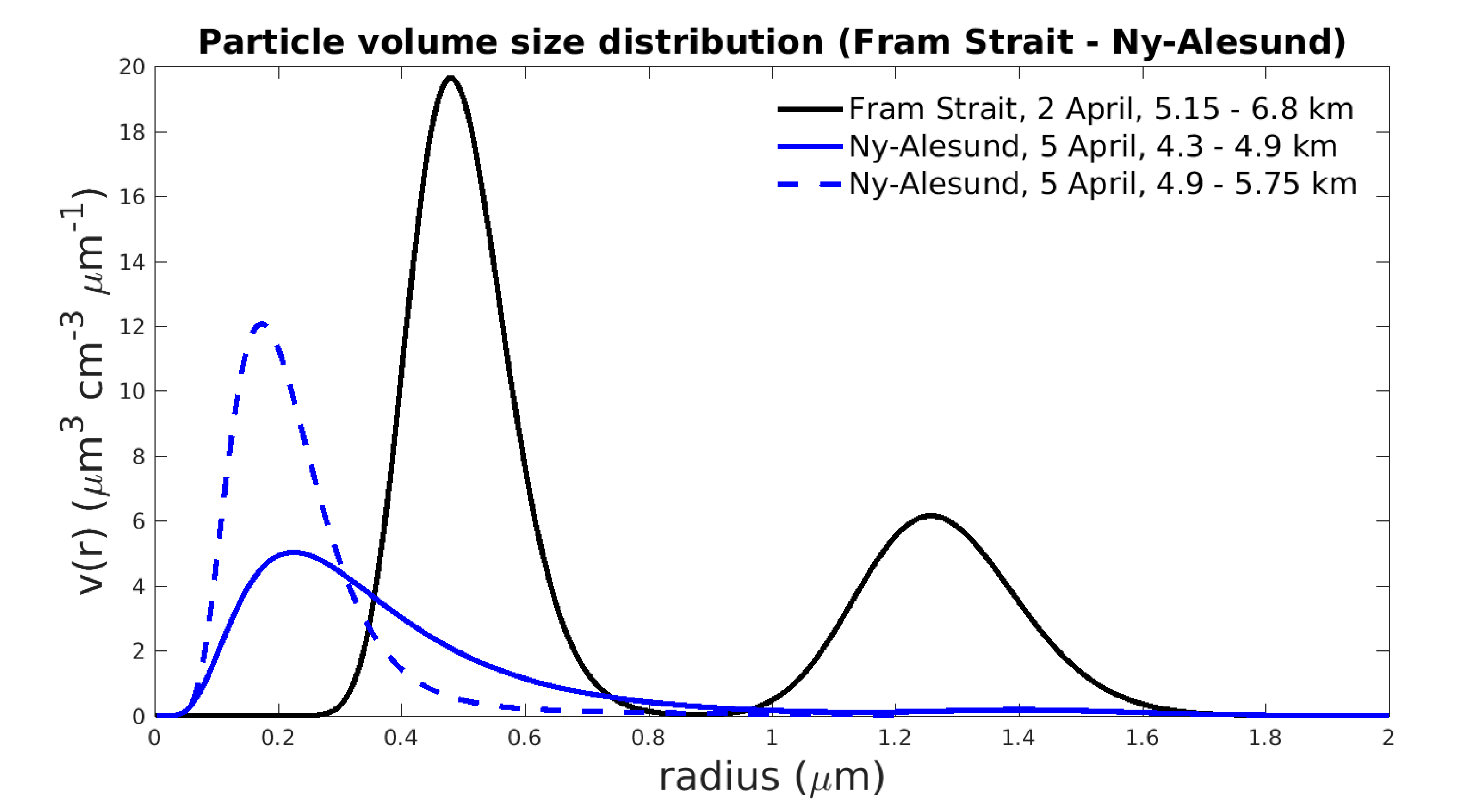
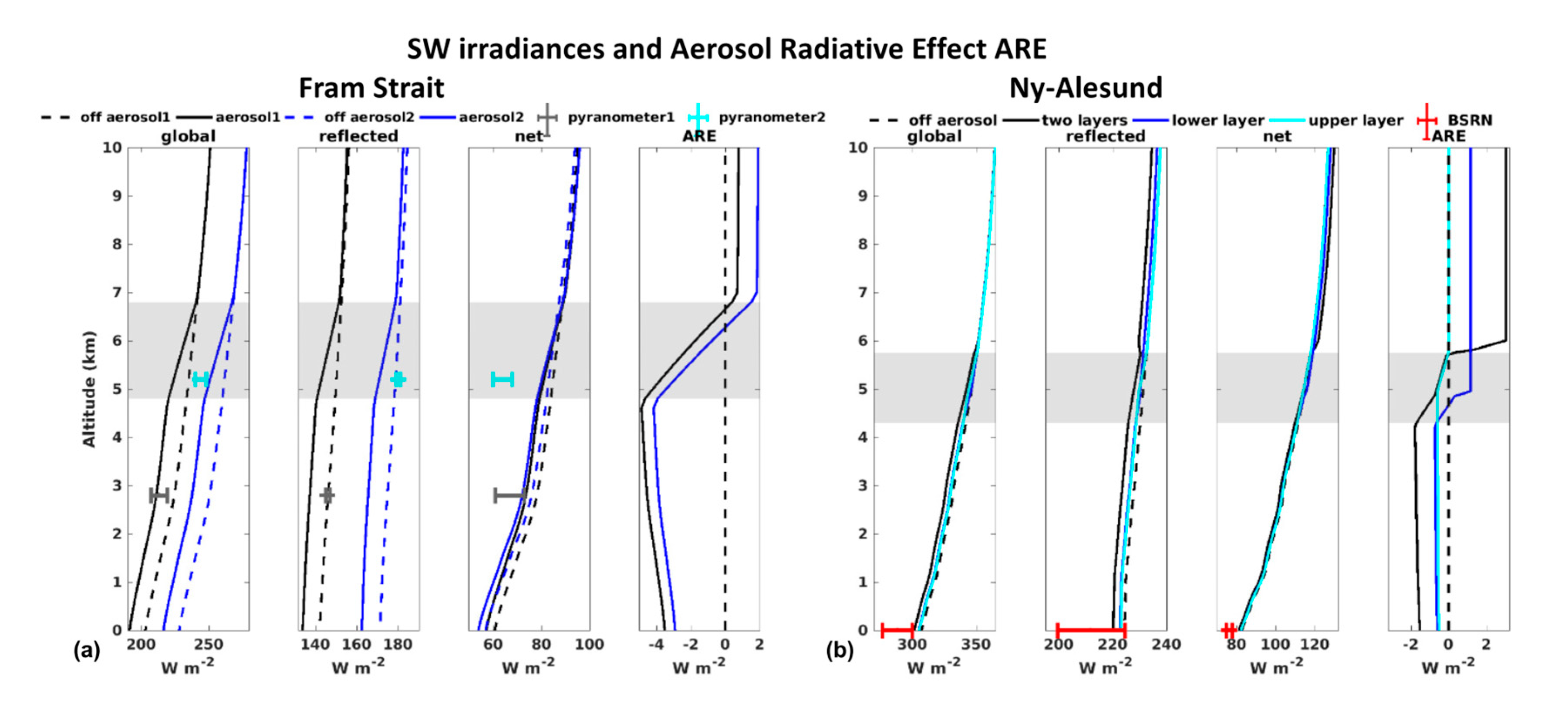
| Aerosol Optical Properties | |||||
|---|---|---|---|---|---|
| Aerosol Properties | Fram Strait (AMALi) | Ny-Ålesund (KARL) | |||
| 2 April | 5 April | 6 April | |||
| 10:31–10:33 | 12:04–12:09 | 11:00–13:47 | 9:51–10:41 | ||
| aerosol layer altitude (km) | 5.15–6.8 | 5.3–6.9 | 4.3–4.9 | 4.9–5.75 | 4.6–5 |
| (Mm−1sr−1) | 1.3 ± 0.3 | 1.7 ± 0.5 | 0.5 ± 0.1 | 0.6 ± 0.1 | 1 ± 0.3 |
| (Mm−1sr−1) | 0.9 ± 0.1 | 1 ± 0.2 | 0.2 ± 0.05 | 0.3 ± 0.06 | 0.4 ± 0.2 |
| (Mm−1sr−1) | - | - | 0.1 ± 0.03 | 0.1 ± 0.03 | 0.2 ± 0.1 |
| 0.8 ± 0.6 | 1.3 ± 0.4 | 1.8 ± 0.2 | 2.2 ± 0.1 | 2.4 ± 0.3 | |
| - | - | 1 ± 0.1 | 1.1 ± 0.04 | 1.2 ± 0.3 | |
| (%) | - | - | 3.8 ± 0.6 | 2.9 ± 0.3 | 3.9 ± 0.8 |
| (%) | 1.3 ± 0.2 | 5.5 ± 1 | 3.2 ± 0.3 | 3 ± 0.2 | 3.4 ± 0.4 |
| Aerosol Layer-mean Optical Properties | |||
|---|---|---|---|
| Aerosol Properties | Fram Strait (Sun-photometer and KARL) | Ny-Ålesund (KARL) | |
| 2 April | 5 April | ||
| 10:52–10:57 | 11:00–13:47 | ||
| aerosol layer altitude (km) | 5.15–6.8 | 4.3–4.9 | 4.9–5.75 |
| (Mm−1) | - | 18 ± 7 | 30 ± 8 |
| (Mm−1) | 20 ± 2 | - | - |
| (Mm−1) | 21 ± 2 | 20 ± 5 | 16 ± 6 |
| (Mm−1) | 27 ± 1 | 12 ± 2 | 12 ± 2 |
| (Mm−1) | 28 ± 1 | 10 ± 2 | 9 ± 2 |
| (Mm−1) | 25 ± 1 | 9 ± 2 | 7 ± 2 |
| (Mm−1) | 20 ± 1 | 7 ± 2 | 4 ± 2 |
| LR355 (sr) | - | 35 ± 15 | 48 ± 4 |
| LR532 (sr) | 15 ± 3 | 82 ± 25 | 64 ± 37 |
| - | −0.3 ± 0.8 | 1.5 ± 1.8 | |
| Åα496-α1026 | −0.09 | - | - |
| Aerosol Microphysical Properties | ||||||
|---|---|---|---|---|---|---|
| Aerosol Properties | Fram Strait (AMALi and Sun-Photometer) | Ny-Ålesund (KARL) | ||||
| 2 April | 5 April | |||||
| 10:31–10:57 | 11:00–13:47 | |||||
| aerosol layer altitude (km) | 5.15–6.8 | 4.3–4.9 | 4.9–5.75 | |||
| Refractive Index ri (mean ± one standard deviation) | ||||||
| ri | 1.5 + 0.008 i ± 0.02 + 0.006 i | 1.54 + 0.019 i ± 0.04 + 0.01 i | 1.49 + 0.007 i ± 0.02 + 0.004 i | |||
| Single-Scattering Albedo SSA (mean ± uncertainty) | ||||||
| SSA355 SSA532 | 0.84 ± 0.1 0.91 ± 0.06 | 0.88 ± 0.06 0.9 ± 0.05 | 0.96 ± 0.02 0.96 ± 0.02 | |||
| Asymmetry parameter g (mean ± uncertainty) | ||||||
| g355 g532 | 0.69 ± 0.04 0.7 ± 0.05 | 0.71 ± 0.04 0.69 ± 0.03 | 0.72 ± 0.02 0.68 ± 0.01 | |||
| Effective radius reff, number nt, surface st and volume vt concentration | ||||||
| fine | coarse | fine | coarse | fine | coarse | |
| reff (μm) | 0.49 | 1.26 | 0.26 | 1.43 | 0.19 | - |
| nt (cm−3) | 8.78 | 0.24 | 65.2 | 0.005 | 132.9 | - |
| st (μm2 cm−3) | 24.09 | 4.68 | 21.6 | 0.13 | 36.4 | - |
| vt (μm3 cm−3) | 3.9 | 1.97 | 1.9 | 0.06 | 2.3 | - |
© 2020 by the authors. Licensee MDPI, Basel, Switzerland. This article is an open access article distributed under the terms and conditions of the Creative Commons Attribution (CC BY) license (http://creativecommons.org/licenses/by/4.0/).
Share and Cite
Nakoudi, K.; Ritter, C.; Böckmann, C.; Kunkel, D.; Eppers, O.; Rozanov, V.; Mei, L.; Pefanis, V.; Jäkel, E.; Herber, A.; et al. Does the Intra-Arctic Modification of Long-Range Transported Aerosol Affect the Local Radiative Budget? (A Case Study). Remote Sens. 2020, 12, 2112. https://doi.org/10.3390/rs12132112
Nakoudi K, Ritter C, Böckmann C, Kunkel D, Eppers O, Rozanov V, Mei L, Pefanis V, Jäkel E, Herber A, et al. Does the Intra-Arctic Modification of Long-Range Transported Aerosol Affect the Local Radiative Budget? (A Case Study). Remote Sensing. 2020; 12(13):2112. https://doi.org/10.3390/rs12132112
Chicago/Turabian StyleNakoudi, Konstantina, Christoph Ritter, Christine Böckmann, Daniel Kunkel, Oliver Eppers, Vladimir Rozanov, Linlu Mei, Vasileios Pefanis, Evelyn Jäkel, Andreas Herber, and et al. 2020. "Does the Intra-Arctic Modification of Long-Range Transported Aerosol Affect the Local Radiative Budget? (A Case Study)" Remote Sensing 12, no. 13: 2112. https://doi.org/10.3390/rs12132112
APA StyleNakoudi, K., Ritter, C., Böckmann, C., Kunkel, D., Eppers, O., Rozanov, V., Mei, L., Pefanis, V., Jäkel, E., Herber, A., Maturilli, M., & Neuber, R. (2020). Does the Intra-Arctic Modification of Long-Range Transported Aerosol Affect the Local Radiative Budget? (A Case Study). Remote Sensing, 12(13), 2112. https://doi.org/10.3390/rs12132112








